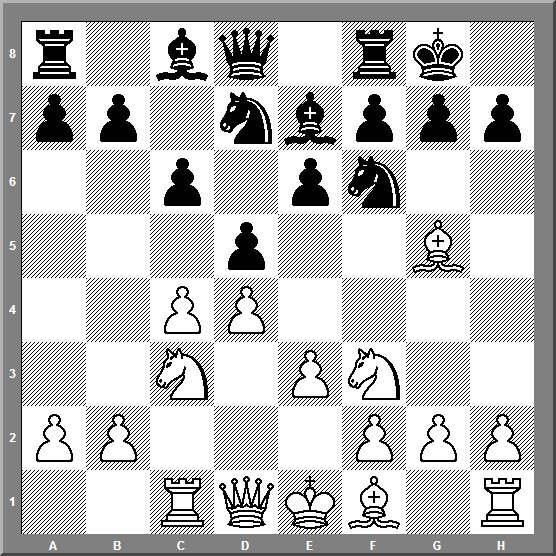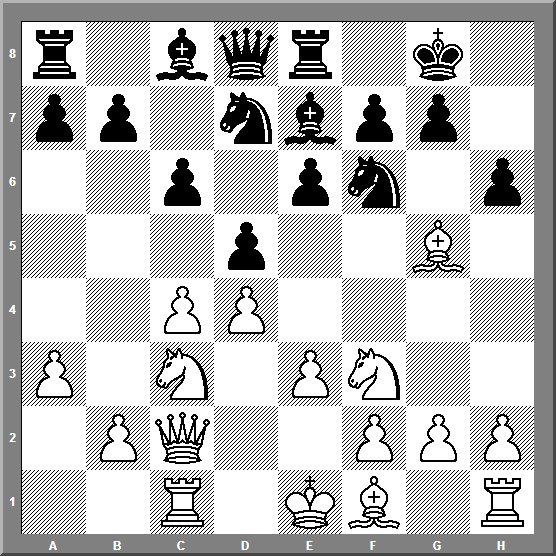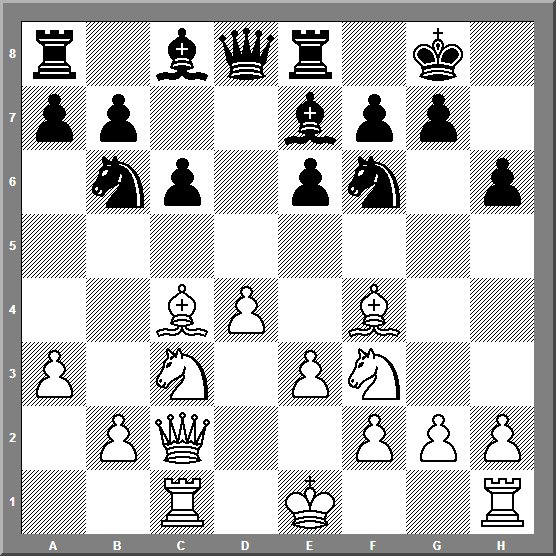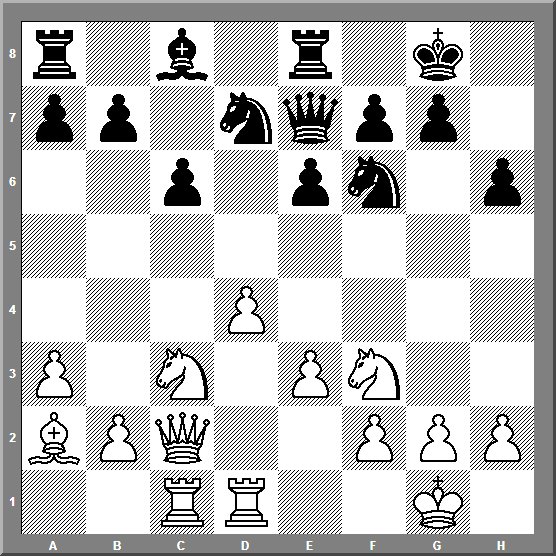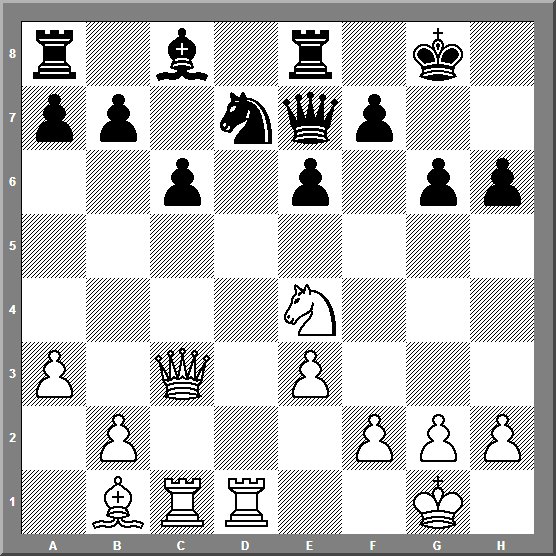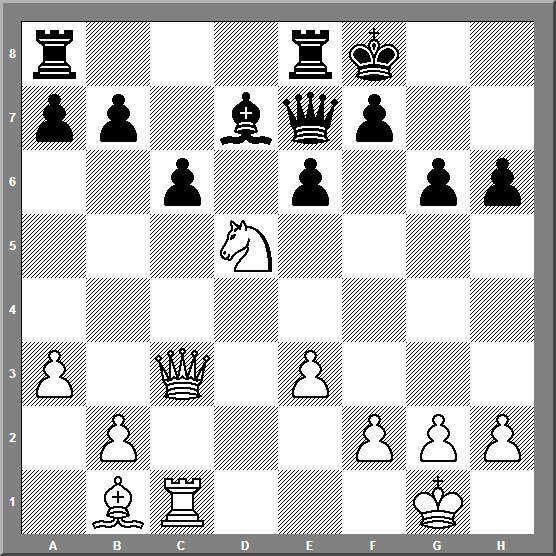All
the |
(Navigation bar
directly below.)
*******
© A.J. Goldsby, 2015.
(All rights reserved.)
****************
Click HERE
to see my
Chess Items.
****************
****************
Buy a book
from Amazon.com
(And help me out as well!)
****************
Click HERE
...
to see a list of the businesses that help to sponsor all of
my chess efforts.
A nice (short) game ... by A. Rubinstein.
I have always felt that Akiba Rubinstein was one of the greatest chess players who ever lived. Every web page that I make with his name on it, I want it to be a small monument to salute one of the greatest players of all time. He certainly was one of the best players who never managed to top the Mount Olympus of chess. (I hope you enjoy my web page, and that you will carefully study the chess of A. Rubinstein.)
Please note that - in the game, below - that I conducted dozens of DPA's. A "DPA" is a deep positional analysis, done with a strong chess engine, usually run for around 4-10 hours. (Sometimes I let it run for 24 hours, or even longer.) I posted the results of what Fritz 12 and Fritz 13 found, this very strong chess engine consistently failed to find the moves that Rubinstein actually played. (And I also tested engines like, "Houdini," "Rybka," "Stockfish," "Deep Shredder," and many others as well. And - just about all of the time - the engines failed to find the moves that the genius of Rubinstein uncovered.) The results of these searches are posted in the game.
**********************
Please
also note that I consistently quote GM
Savielly G. Tartakower.
There are several reasons for this:
-
At one time, Tartakower was easily one of the top GM's in the whole world.
(Jeff Sonas ranks him as #3 in the world in March of 1921! See that page.) -
When it comes to annotations, Tartakower is virtually in a class by himself. If the title of GM were to be awarded for a lifetime of chess work, chess writing and annotations of chess games, then he might be in the ten best who ever commented on a single game ... and one could make a serious case for him being the #1 chess annotator of all time! I don't think that most people even realize just how many games that he actually annotated.)
|
Click HERE to see an explanation of the symbols that I commonly use when I annotate any chess game. Click HERE to replay this game. (Click HERE to see a "star-dot-pdf" / Adobe copy of my analysis.) Click HERE to see my video channel on the "You-Tube" channel. (Click HERE to see my YT video on this game.) |
|
To me, this is simply one of the best games of chess that Rubinstein ever played. All of Black's moves are plausible, every one of Rubinstein's moves are simply a jewel in a setting so beautiful, one dare not disturb the smallest stone. The finished piece is nothing short of a highly polished work of art ... on the chessboard. - A.J. Goldsby I ***** ***** ***** ***** ***** ***** "Rubinstein
the strategist induces a weakening of Black's KB3. Then Rubinstein the
tactician uses ---> "The 1000 Best Short Games of Chess," game # 926, page # 504. (Search for this book.) ***** ***** ***** ***** ***** ***** "A
regular on the Polish chess scene from 1912 to 1940, Moishe Hirschbein was
among the many February, 2014: No ratings were given for these players, as in 1927 the FIDE rating system did not exist. If I had to estimate, I would put Rubinstein down as (easily) 2700+, and his opponent at around 2350.
Akiba Rubinstein - Moishe
Hirschbein
|
|
|
[A.J. Goldsby I]
*************************************************************************************
Rubinstein wins a tremendous
game ... and - in addition - it is a wonderful miniature as well!
(I have seen this game a great number of times over the years, my bibliography -
at the end
of the game - only represents a fraction of the times that I have studied this game.)
The game begins as a normal Queen's Gambit Declined.
[ Both sides follow the four basic principles of the opening. If you study the game carefully, you will see that every one of these moves will accomplish 2-3 of these core concepts. For example, Black's first move, 1...Nf6; does the following:
A.)
Controls key central squares,
specifically, e4 and also d5;
B.) Develops a piece ... towards the middle of the board;
C.) Prepares King-side castling;
D.) Later, it will become obvious - once a Black Pawn occupies the
d5-square -- that the BN on f6 helps protect this key unit.
]
*************************************************************************************
1.d4 Nf6; 2.c4 e6; 3.Nc3 d5; 4.Bg5 Be7; 5.e3 0-0; 6.Nf3 Nbd7; 7.Rc1 c6; (center)
So far, this is all book. (Black's last move helped to cement his control of the vital d5-square,
while
keeping many of his other options open, as well. )
|
|
r1bq1rk1/pp1nbppp/2p1pn2/3p2B1/2PP4/2N1PN2/PP3PPP/2RQKB1R w K - 0 8
Now we have a standard position from this opening.
8.Qc2, (Waiting, maybe -'!')
Rather than play the King's Bishop up ... and possibly lose a tempo, White instead plays the Queen to a good square, perhaps postponing the development of the LSB to a later time.
This is <also> playable, but
the main line is definitely 8.Bd3.
[Consult any good opening manual here ... like "Modern Chess
Openings,"
or even the Encyclopedia of
Chess Openings. ("ECO")]
Several authors praised Rubinstein for this move and even awarded it an exclam here. (Some authors have stated that this idea actually originated with Rubinstein, although I cannot verify this. The earliest known example {that I could find after looking at possibly hundreds of games!} of 8.Qc2 was played in a game between E. Lasker and <also> A. Hodges in 1915. I have also found a game - played by Capa when he was young - where he also employed this move, as well.)
"Rubinstein lives up to his
move, introduced into tournament practice with brilliance in the
game,
Rubinstein vs.
Znosko-Borovsky,
St. Petersburg, 1909." -
S. Tartakower.
[Replay
that game - on the CG website.]
[When I first wrote the above
words, I did not have a copy of the 1909 tournament book, nor could I
locate the above referenced game. However, all of this changed within a
few years. A former student of mine - now a pilot for the U.S. Navy - went
to the Library of Congress. He got me a copy of the original bulletins of
the tournament.
And the above game is now available for replay on the "Chess
Games" website.]
[ The most commonly played
line would be the following continuation:
(>/=)
RR 8.Bd3 dxc4;
9.Bxc4 c5!?;
Maybe this is Black's most energetic alternative here?
(Or Black can play: 9...Nd5!?; which would be the
<standard> Capablanca freeing maneuver.)
10.0-0 cxd4;
11.exd4,
"+/="
and White is just slightly better in this position.
[ See MCO-15, beginning on page # 393, col.'s # 1-18 ...
and all applicable notes. ] ]
8...Re8; (Going for ...e7-e5?)
Black plays the Rook to a central file, perhaps thinking of a later Pawn break in the center of the board.
This move is not terrible, however it may not have been Black's most vigorous follow-up in this position.
"It is still not clear as to which answer is Black's best ..." - GM Savielly Tartakower.
[ Probably better was:
(>/=)
RR 8...a6!;
9.a3!? h6;
10.Bh4 Re8; 11.Bd3 dxc4; 12.Bxc4
b5; 13.Ba2 Bb7;
14.0-0 c5;
"~"
(unclear, maybe "+/=")
when Black has nearly equalized here. ]
9.a3!, (The purpose?)
White plays a move that has prophylactic aims, perhaps with several ideas in mind:
#1.) Prevent any pin/exchange (of White's Knight on c3) which starts with ...Bb4 by Black.
#2.)
Now that the White Queen is on c2, it might be a good idea
for White to prevent a
Black
Knight from getting to the b4-square.
#3.)
White's LSB now has a new hiding square on a2, which might
be followed up by Bb1
and then
Rubinstein has mating threats against the Black King.
#4.)
Maybe Rubinstein is thinking about playing b2-b4, gaining
space and this also discourages
Black from playing his standard
break of ...c7-c5.
#5.)
I saw one game in the DB - sometime in 2013 - where two
masters played this system.
The first player got tremendous
Q-side play with b2-b4. This was followed by re-posting
the Rooks to b1 & c1. Then
White played b4-b5, with a really smashing game.
******************
Several authors liked this
move so much that they awarded it an exclam.
('!' - GM S. Tartakower.)
"Much better than 9.Bd3, and
the best way to continue in the fight for the tempo."
- GM Savielly Tartakower.
[ RR 9.Bd3, - Fritz 13. ]
9...h6!, (Asking the question.)
Black "kicks" White's DSB.
(This forces White to make a decision about the placement of his Bishop. Further, Black
gains space,
gets a "luft" square for the Black King and does all of this with no loss of time.)
|
|
r1bqr1k1/pp1nbpp1/2p1pn1p/3p2B1/2PP4/P1N1PN2/1PQ2PPP/2R1KB1R w K - 0 10
I award this move an exclam ...
for a couple of reasons:
A.) It is the first choice of strong chess engines like Fritz 13,
Houdini and Deep Shredder.
B.) Several old books and magazines universally
condemned this move!
[ One {former} student recommended that Black play his immediate
break on the center ... which, in theory, should not be a bad idea:
(</=) 9...c5!?;
('?!') 10.cxd5
exd5; 11.Be2, "+/="
(White is a
little better.)
and the first player holds the upper hand because Black will get either an
isolated QP or the "hanging pawns" structure. [Tartakower recommended
9...a6!; here, instead of the continuation played in the actual game.]
]
10.Bf4!, (Centralization.)
White plays a nice move, it hits the key e5-square and also prevents Black from getting any ideas about playing for the center break of ....e7-e5.
This Bishop is also very annoying for the second player ... it makes it hard for Black to generate any meaningful game plan with this DSB (dark-squared B) slicing through the heart of his position.
(10.Bf4! - GM S. Tartakower.)
[ RR 10.Bh4 , - Fritz 13. ]
10...dxc4!?; (hmmm)
Black surrenders the center ... without even being asked.
(Normally, Black waits until White has played Bd3 before playing this move ...
in order to {first} gain a tempo by forcing the White LSB to move a second time.)
[ Probably the following moves were all a
slight improvement over the text move:
A.) 10...Qa5. -
Fritz 13.
B.) 10...Ne4 -
Deep Shredder.
C.) 10...Nh5!? -
Houdini. ]
In Black's defense, the idea of ...d5xc4; is a standard idea for Black in the QGD, and allows the second player to begin a process whereby he can eventually free his QB from its prison of Pawns ... most of which are
(now) currently
located on light squares.
11.Bxc4 Nb6!?; (What the!?!?)
Black is trying to get his pieces out and get some play as well.
|
|
r1bqr1k1/pp2bpp1/1np1pn1p/8/2BP1B2/P1N1PN2/1PQ2PPP/2R1K2R w K - 0 12
Normally - all the books teach that this is a bad (inferior) square for this piece.
[However, this move is the first choice of several engines, to include Fritz 13.]
This is another one of those moves - in this game - that was nearly universally condemned in many of the older chess magazines. (Whether it is really good or bad ... I leave for the reader to resolve for themselves.)
[Perhaps - given the play thus far - Black
could do no better than playing the Knight to b6.]
[ I think a fair improvement would probably have to be the following game:
(>/=) RR
11...a6; 12.0-0 b5;
13.Be2 Bb7; 14.h3,
"+/="
when White should have a small edge in this position.
Zurab Sturua
(2450) - Andrei Kharitonov;
(2300?) / [D64]
Soviet Championships, (URS-ch) / Tallinn, Estonia; 1981.
(0-1 in 41 total moves.) ]
12.Ba2, (preparation, maybe, probably -'!')
When I was a "Class C" player, a move like this definitely would have confused me.
Today, I realize that this is a good move ... for the following reasons:
#1.) It hits the center square of d5.
#2.) It gets this diagonal killer completely out of the way of White's other pieces.
#3.) It prepares the retreat of the LSB to b1, setting up a killer battery on the important b1-h7 diagonal.
(Once White has both his Queen and Bishop pointed directly at the Black King, mate threats will arise.
To stop these mate threats, the second player will be forced to weaken his King-side position.)
[ RR 12.Bd3, - Fritz 13. ]
12...Bd6!?; (nullification)
Black exchanges off White's monster Bishop on f4, perhaps (now) with some preparation, the second player will be able to accomplish the ...e7-e5; pawn break.
While Black's move appears to be good and completely logical, all the engines see a rather sharp rise in the overall evaluations of the current position on the chess board. (Black loses a significant amount of dark-square control by this exchange of the dark-squared Bishops here.)
"Under the slogan of simplification. But, as we shall soon see, this only simplifies the opponent's victory.
Consistent was, of course, 12...Nbd5." - GM S. Tartakower.
[
The following line had to represent a significant improvement
over the course of the actual game: >/= 12...Nbd5!;
13.Be5 Qa5;
14.0-0 Nxc3;
15.Qxc3 Qxc3;
16.Rxc3, "+/="
(with an advantage);
when White has a solid edge.
However, it is not that large, and Black is in no danger of
an immediate loss, as he was in the actual game.
]
Seeing that he has no good square to retreat his QB to, Rubinstein goes ahead and swaps it off.
[13.0-0, looks like an error, White gets doubled Pawns after Black swaps on the f4-square. The
next three ply, (1.5 moves); look to be OK, and nearly best/forced for both sides.]
13.Bxd6 Qxd6; 14.0-0 Nbd7; (Black retreats?)
Black is thinking about preparing the ...e7-e5 break, but this rather tame move does not appear to get the job done, although the strong engine, Houdini, seems to prefer this move over all the other alternatives here for Black.
"With the vain hope of ...e6-e5." - GM Savielly Tartakower.
[ Maybe RR
14...Rd8;
or even RR
14...Nbd5; were a very,
very slight improvement over the text move here. ]
******************************
Now White discourages Black from playing ...e7-e5; by placing his Rook on d1.
(Now 15...e5??;
would be a very bad move. After 16.dxe5, "+-" Black would not be able
to recapture on e5,
as his Queen would be hanging, as a result, Black would lose at least a piece.)
I should also note that Tartakower also awarded White's 15th move an exclamation point.
(15.Rfd1! - GM S. Tartakower)
15.Rfd1! Qe7; (Too routine?)
Black gets off the line/file of White's Rook on the d1-square.
|
|
r1b1r1k1/pp1nqpp1/2p1pn1p/8/3P4/P1N1PN2/BPQ2PPP/2RR2K1 w - - 0 16
Maybe placing the Queen on c7, would have been a slight improvement over the actual game.
[ After (>/=) 15...Qc7; Black would have better control of the vital e5-square. ]
16.Ne5!!, (Why is it good?)
There are four basic principles that govern middlegame play. (Attack, try to get active posting of your pieces, make and exploit weaknesses, and also you should be looking for a favorable transition to the endgame.)
I have studied literally thousands of master-level games, and one of the first things that a strong player will do ... especially in closed or semi-closed positions ... is to place a Knight on a strong square. (Outpost!)
This move is worthy of TWO exclamation points, as it also may entail - by force - a Pawn sack by White.
(Rubinstein had to look deeply into the position to ensure that this Pawn sack was going to work ...
White could have easily been left down a Pawn, with nothing to show for it.)
I think that this is also ... yet another example ... of the second Morphy Principle in action. ("When you have all your pieces properly developed - and your opponent does not - then you should purposely try to open the game up as much as possible.")
[ RR 16.Ne4!?, "+/=" - Fritz 13. ]
16...Nxe5; (Kill the intruder!)
It is only natural that Black would want to remove the offending Knight.
However, there is a well known rule of thumb that a defender, (esp. someone who is defending a blatantly inferior position); should never open lines, so this exchange is a clear violation of that concept. (Usually - open lines favor the player with the upper hand, this is why you do not want to open lines when you are defending an inferior position. The results favor the attacker the majority of the time.)
In Black's defense, the exchange on d5 appears very strong ... and even seems to win a pawn, as well. (Several chess engines - to include an earlier version of Stockfish - seem to prefer this exchange of Knights on e5.)
[ RR 16...Rd8; - Houdini 1.5; RR 16...Nd5; - Fritz 13. ]
White has no good move other than to retake the Knight on e5.
17.dxe5 Ng4; (Hitting the Pawn on the e5-square.)
This move - which is the first choice of most chess engines - is criticized by Tartakower who comments that:
"Better was 17...Nd7." - GM Savielly
Tartakower.
[ RR
17...Nd7!?;
('?!') 18.f4,
'±' ("+/") -
Fritz 13.
(This engine considers White's position to be won ...
by nearly two full points, although White has not
{yet}
won any material here. However, White does have a very
powerful attack, all of his pieces have full play, and there
are an abundance of useful open lines. Meanwhile, most
of Black's pieces are in bad or nearly useless positions.) ]
18.Bb1!, (Battery!)
This move, which threatens a simple mate in two, (Qh7+, and then Qh8#); virtually forces Black to push his KNP and further weaken his position.
One of the first books - published in America - was by the Irish-born Mason. In that historic volume, he advised players to try and get your pieces working together and pointed at the enemy King.
[ Not as accurate would be: </=
18.Qe4?! Qh4!;
"<=>" (counterplay)
when Black has a fair amount of play and may not be in any real
danger at all. ]
18...g6[]; (100% forced.)
Black had no choice at all, not in this position.
[ Of course not: </= 18...Nxe5??; 19.Qh7+ Kf8; 20.Qh8#. (mate)
*********************************
Also bad for Black was:
</= 18...f5?!;
19.exf6 Nxf6; 20.Ne4!,
'±' ("+/")
- Fritz 13.
when all the engines seem to indicate that White already
has a winning attack. ]
Now ... rather than even try to defend his Pawn on e5, White simply sacrifices it.
19.Ne4! Nxe5; (Booty!)
Black appears to have won a Pawn, however, now all of the engines are already finding the win for White.
Black has won material, but all of White's pieces are in very good positions. Probably the straw that breaks the back
of the second player is that Hirschbein has a grossly weakened Kingside ... in addition to his under-developed
Queen's-side.
[ RR 19...Rf8; 20.Qc3, +- ]
20.Qc3!, (Attacking the Knight!)
One of the first things you learn to do as a chess player is to go after the unprotected piece.
Averbakh said - in his landmark book on tactics - that double attacks form the foundation of every good combination.
[ RR 20.f4!? Ng4; 21.Qc3, "+/=" 20...e5!; "<=>" ]
20...Nd7; (A safe square?)
Black retreats to a place that looks secure. In addition, if Black had just a few moves, he could easily untangle his position and try to use his extra Pawn to win the game.
|
|
r1b1r1k1/pp1nqp2/2p1p1pp/8/4N3/P1Q1P3/1P3PPP/1BRR2K1 w - - 0 21
Unfortunately for Black, the position has now become a tactical puzzle, with ... ... ...
"White to move and win."
[ RR
20...Ng4; 21.h3 f5;
22.Nd6, "+-" (White's winning.)
All the engines eventually find this line, and they universally
agree that White has a decisive advantage here.
]
*******************************************************************
With his next move, Tartakower comments that Rubinstein is: (giving)
"An object lesson in how to make the most of a weak f6-square." -
GM S. Tartakower.
('27.Nd5!' - S. Tartakower.)
Of course, after 21.RxN/d7!, Black cannot capture with the Queen, as 22.Nf6+,
would fork
both the King and the Queen and end the game.
21.Rxd7! Bxd7; 22.Nf6+ Kf8; 23.Nd5!, "+/-" Black Resigns.
The second player quits because he has to either lose his Queen ... or get mated.
(23.Nd5!! - GM S. Tartakower.)
|
|
r3rk2/pp1bqp2/2p1p1pp/3N4/8/P1Q1P3/1P3PPP/1BR3K1 b - - 0 23
This game is a true jewel ... and one of the finest miniatures that I have ever deeply analyzed. All of Black's moves were logical and plausible, there was no gross blunder, Rubinstein simply outplayed Moishe Hirschbein.
************************************************************************************
BIBLIOGRAPHY:
#1.) "The 1000 Best Short Games
of Chess," by Irving Chernev. (Game # 926, page # 504.)
#2.) "Akiba Rubinstein, The
Later Years," by IM's John Donaldsen and Nikolay Minev. (Game # 280, page # 160.)
[When
I first started annotating this game, I did not have this book. I knew
that I had to get this book before I could post my analysis.]
#3.) "Rubinstein's Chess Masterpieces,
100 Selected Games," by Hans Kmoch.
(Dover - 1960. This game is not there,
but I did play over all the other QP games by the great Rubinstein.)
#4.) Shakhmatny Listok, 10/1927.
#5.) "Neue Wiener Schachzeitung."
June, 1927.
Copyright (c) A.J. Goldsby, 2004. All rights reserved.
(I started on this game in 2004 ...
but for whatever reason, I never finished the task. For dropping the ball on this
one,
I can only apologize and comment that it had to have been caused by the great turmoil in my own
personal life. My
wife
got very ill in 2001, and in 2003, she was diagnosed with
cancer. ---> She died in January of 2008.)
Copyright (c) A.J. Goldsby, 2013. All rights reserved.
Copyright (c) A.J. Goldsby, 2014. All rights
reserved.
1 - 0
The analysis for this page was prepared with the excellent program,
ChessBase
10.0.
(I
now have ChessBase 11.0; I also used MANY different chess engines ... during the
course of my analysis!)
---> My main engines - for this game - were
Fritz 13, Deep Shredder, and Houdini 3.0.
The HTML was polished with several different tools and programs, (mostly FP) ... the text was checked for spelling with MS Word..
|
Go ... or return ... to my Home Page for this site. Go (or return) ... to my "Annotated Games" (II) Page. Go
... or return ... to my "Best
Games" Page. *******
Copyright (c)
LM A.J. Goldsby
I ******* This
page was first generated in: October,
2013. |
